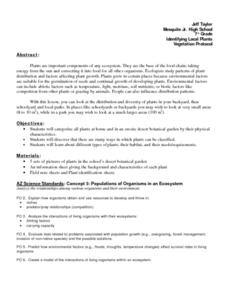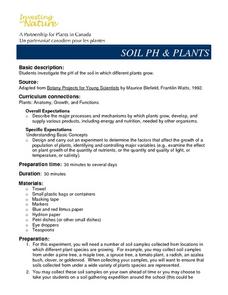Chicago Botanic Garden
Preparing for Project BudBurst
Adopt a plant and get to know its phenophases. The third instructional activity in a six-part series combines plant identification and phenology. Pupils begin by creating their own field guides to learn about the features and...
Chicago Botanic Garden
Preparing for Project BudBurst
Plants take cues from the environment—change in daylight hours and temperature—to complete their seasonal life cycles. Lesson four in the series of six has classes collect phenology data on plants. After taking initial observations,...
Chicago Botanic Garden
Preparing for Project BudBurst
Male deer growing antlers to begin the breeding season is an example of a phenological event. First in a four-part series is an activity requiring individuals to collect phenological data on their campus. Classes discuss phenology, the...
Curated OER
Build a 3-d Plant Model
Third graders construct a three-dimensional model of a flowering plant. They examine the major plant parts and their basic functions. They demonstrate an understanding of the similarities and differences in the physical...
Curated OER
Plant Identification Pictionary
Students participate in a plant identification game. Using worksheets, they collect plant samples and identify the basic parts of the plant. They note the similarities and differences between the various diagrams. They use heavy books...
Curated OER
Schoolyard Jungle: What's Out There?
Eighth graders create a plant study guide using their outdoor classroom environment. For this ecology lesson, 8th graders take photographs of plants they collect from the outdoor classroom and create plant field guides. Students design...
Curated OER
Plant Disease Identification and Classification by Using Sterile Techniques
Seventh graders identify how to use sterile techniques when identifying plant pathogens. For this plant diseases lesson students complete a lab activity in which they see how plant diseases are identified and classified.
Curated OER
Plant Identification: New Jersey vs. Ecuador
Sixth graders discover the different plants that grow in different climates through specimen collections. In this botany lesson, 6th graders examine plants from both New Jersey and Ecuador and discuss what conditions could create such...
Alabama Wildlife Federation
Leaf Creatures
The structure of a leaf reveals a lot about the plant it comes from. Young scholars collect and prepare leaves for comparison. After pressing the leaves, they identify the different parts and then use the leaves to complete an art project.
Curated OER
Arizona Plant Booklet: An Introduction to Arizona Plants & Cacti
Students explore variety of plants & cacti in their Arizona community by collecting samples and taking photographs. Can be adapted to other areas.
Curated OER
Temperature and the Tomato
You will need a photovoltaic system and monitor at your school in order to obtain all of the data required to thoroughly implement this instructional activity. Your class monitors daily temperature and insolation amounts over a two week...
Curated OER
Using Sterile Techniques as a Tool in Studying Plant Diseases
Seventh graders examine the concept of sterile techniques. They realize that plant diseases can be identified and classified in various way. Students identify some of the diseases that attack the garden plants.
Curated OER
Investigative Case - "Malama Keone'o'io"
Students study techniques for conducting a local environmental assessment in an ecologically sensitive area. Identification of native plants and methodologies for sampling is taught in the classroom and then reinforced in the field. The...
Curated OER
Field Biology
Students work with 4th and 5th graders at Cascade Brook School in Farmington, to teach them skills in wildflower and fern identification, and then to help them implement a nature trail, which is accessible to the greater Farmington...
Curated OER
Disposable Diaper Comparison and Mystery Powder Identification
Students investigate which diaper is the most absorbent. In this chemistry lesson, students calculate how much water is absorbed by diapers. They identify an unknown powder based on physical and chemical properties.
Curated OER
U.S. History: Antebellum Heroes and Villains
Eighth graders research and write reports on key figures of the Antebellum Period. The projects also include pictures, bibliographies, and timelines about their assigned figure. In addition, 8th graders present oral reports to classmates.
Curated OER
Prairie Find Outdoors
Young scholars take a field trip to a local prairie. Using identification books, they identify various forbs and grasses in the prairie. As a class, they discuss the importance of forbs and grasses to the ecosystem and review the various...
Curated OER
Soil pH & Plants
Young scholars investigate the pH of the soil in which different plants grow. They design and carry out an experiment to determine the factors that affect the growth of a population of plants, identifying and controlling major variables...
Curated OER
Science Inquiry Lesson: Mapping Project
Students explore the methods of creating maps. They create a map of Animas River Park using a compass and measuring tape, develop a single map from the team map sections, and devise another map of the Animas River Park using a GPS unit.
Curated OER
Thin Layer Chromatography (TLC)
Learners study flavinoids and how they exist in the plant kingdom. In this pigment lesson students complete a lab activity to see how flavinoids move in substances then record their observations.
Curated OER
Let it Grow!
Students explain the relationship of plants and animals in the environment. They name the basic requirements for plant growth and define the terms photosynthesis, stomata, chlorophyll and xylem.
Curated OER
Flowera of the Prairie
Young scholars with severe disabilities view pictures of flowers in a scanning box and identify them. Outside, they locate flowers on the school's property, label and care for them. Students use flower pictures to aid identification.
Curated OER
Habitat Unit - Day 2
Learners explore abiotic factors that affect habitats. After a class lecture, students work in groups to answer questions about plant tissue, production and growth. They share answers, complete a crossword puzzle, and create a habitat...
Curated OER
Fossil Kit I - Lesson Plan
Here is a 14-page lesson plan that deftly outlines a wonderful educational experience for your youngsters. In it, students learn about a variety of animals that have left behind clues of their existence in fossil form. Many excellent...

























